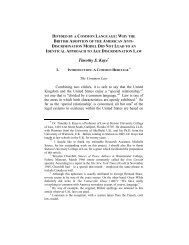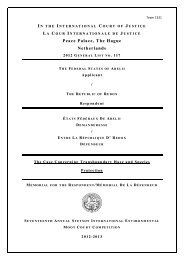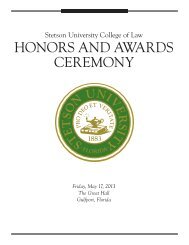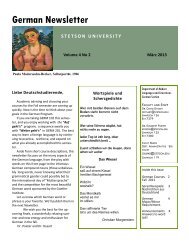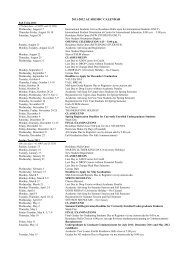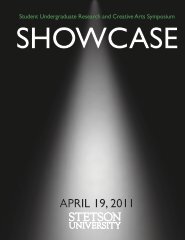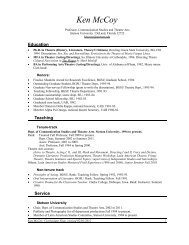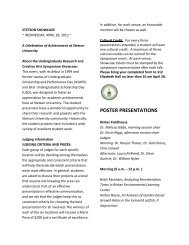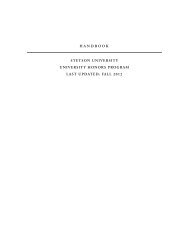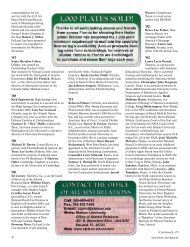Tiffany Huet Class of 2008 Justifying Violence: A ... - Stetson University
Tiffany Huet Class of 2008 Justifying Violence: A ... - Stetson University
Tiffany Huet Class of 2008 Justifying Violence: A ... - Stetson University
Create successful ePaper yourself
Turn your PDF publications into a flip-book with our unique Google optimized e-Paper software.
<strong>Tiffany</strong> <strong>Huet</strong><br />
<strong>Class</strong> <strong>of</strong> <strong>2008</strong><br />
<strong>Justifying</strong> <strong>Violence</strong>:<br />
A Critical Comparison <strong>of</strong> Dietrich Bonhoeffer, Michael Bray and Osama bin Laden<br />
Religious Studies<br />
Spanish (minor)<br />
April <strong>2008</strong><br />
Pledged: <strong>Tiffany</strong> <strong>Huet</strong> (Signature)<br />
Approved: D. Dixon Sutherland, Faculty adviser<br />
Mitchell Reddish, Chair, Religious Studies
Abstract<br />
This essay is an inquiry into the ethics <strong>of</strong> justifiable violence in its extreme form, namely,<br />
killing another human being. The question raised by the author is whether Dietrich Bonhoeffer’s<br />
justification for planning the assassination <strong>of</strong> Adolf Hitler is comparable to the logic used by<br />
Michael Bray or Osama bin Laden. Differences in method <strong>of</strong> justification <strong>of</strong> killing between the<br />
three are analyzed and inconsistencies in logic are critiqued.<br />
2
Introduction<br />
This paper is about the ethical justification <strong>of</strong> killing from religious convictions. Initially,<br />
my interest in the question <strong>of</strong> the ethical questions about violence was embedded in the writings<br />
and actions <strong>of</strong> Dietrich Bonhoeffer, a German theologian during World War II, who attempted to<br />
assassinate Hitler and was ultimately killed for it. It was interesting to read his initial, pacifistic<br />
beliefs about what the Christian should look like today and then see him seemingly contradict<br />
himself later with this deliberate proposal and plan <strong>of</strong> premeditated violence. How is it that a<br />
man who claims a Christian should live for others (as opposed to living for oneself) is able to<br />
justify an elaborate conspiracy to kill someone? Of course, I realize that this person we are<br />
discussing is Hitler, who is frequently used as the epitome <strong>of</strong> evil in human form; however, the<br />
basis <strong>of</strong> the question I was raising in these initial phases <strong>of</strong> my study was not concerning the<br />
concentration <strong>of</strong> evil found in Hitler’s undoubtedly disturbed psyche. The question was<br />
concerning Bonhoeffer’s adherence to his own code <strong>of</strong> ethics, which he adjusted as he<br />
experienced and witnessed the evil <strong>of</strong> Nazism and became involved in active resistance. Why the<br />
adjustment? How does he drastically alter his ethic to fit in the action <strong>of</strong> tyrannicide? These<br />
questions (and more) were answered, I found, in a rather remarkable and innovative work by<br />
Larry Rasmussen.<br />
Hence, the shape <strong>of</strong> this present study has become comparative. I wanted to understand<br />
which justifications, if any, for an act <strong>of</strong> violence could actually justify the violent act. As a<br />
result, I decided to compare two examples <strong>of</strong> Christian violence and one <strong>of</strong> Muslim “terrorism”<br />
with the underlying question, “Does any difference exist between the two?” The purpose <strong>of</strong> this<br />
paper is, therefore, to analyze and contrast the logic whereby each <strong>of</strong> the proponents <strong>of</strong> killing<br />
3
other human beings justify their decisions. The first instance is the well-documented and well-<br />
known assassination attempt by Dietrich Bonhoeffer on Adolf Hitler. The second is from within<br />
the Christian pro-life movement; specifically the militant movement advocated by the group the<br />
“Army <strong>of</strong> God.” One <strong>of</strong> the key players in this movement will be targeted. Reverend Michael<br />
Bray, who was imprisoned for violent actions against abortion clinics and has clearly delineated<br />
his justification for his beliefs and actions in his book entitled A Time to Kill: A Study<br />
Concerning the Use <strong>of</strong> Force and Abortion. The last example is the contemporary actions <strong>of</strong><br />
Islamic fundamentalism, namely, Osama bin Laden. Bin Laden has funded and directed horrible<br />
acts <strong>of</strong> violence against the United States and has been blatant with his beliefs about why he feels<br />
his cause is justified. I will draw parallels between these justifications, seeking their similarities<br />
and differences from one another.<br />
Dietrich Bonhoeffer<br />
Bonhoeffer decided early in his life to be a theologian and began his body <strong>of</strong> work during<br />
his years at Berlin <strong>University</strong> (1924-1927). 1 He was a prolific writer who allowed his life<br />
experience to affect his writing and vice versa. This created a body <strong>of</strong> work that is reflective <strong>of</strong><br />
the personal struggles he had with his changing environment and his central question about who<br />
Jesus would have been in the midst <strong>of</strong> warfare, hatred, and dictatorship. 2 The answer to this<br />
question, however, changes as Bonhoeffer becomes more deeply involved in the clandestine<br />
resistance against Hitler. A study <strong>of</strong> the shifts in Bonhoeffer’s theology, ethics, and action<br />
demonstrates how he developed from a convinced pacifist to a conspirator in one <strong>of</strong> the most<br />
1 J. Deotis Roberts. Bonhoeffer and King: Speaking Truth to Power. Westminster John Knox<br />
Press: Louisville, Kentucky (2005): 19-20.<br />
2 Larry Rasmussen. Dietrich Bonhoeffer: Reality and Resistance. Westminster John Knox Press:<br />
Louisville, Kentucky (2005): 75. Much <strong>of</strong> this analysis is greatly influenced by Rasmussen’s fine<br />
work.<br />
4
enowned instances <strong>of</strong> religious resistance in history. Larry Rasmussen focuses on this question<br />
in his analysis <strong>of</strong> Bonhoeffer’s theology, ethics, and resistance: “If Christology is indeed at the<br />
center <strong>of</strong> Bonhoeffer’s thinking, where is the key here to his move from passive to active<br />
resistance?” 3<br />
Dietrich Bonhoeffer began as a pacifist, arguing that Christ was at the center <strong>of</strong> all reality<br />
and was “the man for others.” 4 His lectures on Christology in 1933 examine the meaning <strong>of</strong> faith<br />
and relationship with God in light <strong>of</strong> this understanding <strong>of</strong> Christ. He claims that faith is the<br />
human participation in Christ’s “being for others.” 5 What he meant by this was that Christ’s<br />
existence could only be seen in relationship with another person. Bonhoeffer says Christ “is his<br />
being pro me.” 6 In other words, Christ’s life on earth was intentional; his purpose was not, in any<br />
sense, selfish, given that others might find freedom and salvation. Christologically, since<br />
Bonhoeffer understood that Jesus was God emptied into a man, infinity emptied into a finite<br />
human being, everything—“[humanity], nature, and history” revolves around Christ. 7 He is the<br />
center for all reality, for Bonhoeffer. Moral action, judged from Bonhoeffer’s perspective, is in<br />
accordance with reality (Christ), and immoral action “deviates from Christ’s form in the world.” 8<br />
Christ’s being was oriented outwards, toward others and not toward himself. As Rasmussen<br />
concludes, “Bonhoeffer is declaring that because Christ is in, with, and under human sociality, a<br />
[human] only finds self-fulfillment, indeed self-formation, in being with and for others; and<br />
being with and for others is the way in which a [human] is formed in Christ.” 9 The “centrality <strong>of</strong><br />
3 Rasmussen, 36.<br />
4 Rasmussen, 18.<br />
5 Rasmussen, 21.<br />
6 Rasmussen, 18.<br />
7 Rasmussen, 15-16.<br />
8 Rasmussen, 23.<br />
9 Rasmussen, 20, italics mine.<br />
5
Christ” gave humans the “freedom to love God and neighbor, and stranger, and enemy.” 10 Thus,<br />
Bonhoeffer’s ethic claims that one who adheres to Christ is committing to be held responsible for<br />
others in the sense that we have a responsibility to love one another as Christ loved us.<br />
Responsibility, for Bonhoeffer, is a human response to “the reality which is given us in Jesus<br />
Christ.” 11 As Lori Brandt Hale describes, Bonhoeffer understood Christ’s demonstration on the<br />
cross as dissolving the distinctions and spiritual hierarchy between humans. She says, “We are<br />
human beings with our suffering, joys, sorrows, desires, disappointments, and fulfillments—and<br />
most important, human beings with our sin and guilt, faith, and hope.” 12<br />
For Bonhoeffer’s ethics, therefore, this means that in everyday decision-making, one<br />
must look to consult the form <strong>of</strong> Christ in the world or conform to reality, which are essentially<br />
the same thing for him. 13 However, Christ’s form in the world today is historically conditioned<br />
and this is where Bonhoeffer leaves room in his ethic for circumstance and history. Bonhoeffer<br />
maintains that while “Christ is the same yesterday, today, and forever,” the Christ we conform to<br />
today “may not be who Christ was for us yesterday.” 14 Therefore, when the church gives a<br />
command on what sort <strong>of</strong> action to take, Bonhoeffer says it must take this variable into account.<br />
The church must have the “well-informed knowledge <strong>of</strong> the ever-changing context <strong>of</strong> decision,”<br />
so as to interpret Christ in terms <strong>of</strong> what he would be like in today’s situation. 15 This authority<br />
must come from a church that has full knowledge <strong>of</strong> the state <strong>of</strong> the world before it gives<br />
guidance on moral action. Bonhoeffer concludes, that, for the world at the time (1932), “today<br />
10 Hale, Lori Brandt. “From Loving Enemies to Acting Responsibly: Forgiveness in the Life and<br />
Theology <strong>of</strong> Dietrich Bonhoeffer” Word & World Vol. 27, number 1 (2007): 80.<br />
11 Rasmussen, 37.<br />
12 Hale, 81.<br />
13 Rasmussen, 22.<br />
14 Rasmussen, 24.<br />
15 Rasmussen, 24-25.<br />
6
God’s command for us is the order <strong>of</strong> international peace.” 16 Bonhoeffer continued preaching<br />
this message well into Hitler’s reign. Hale summarizes:<br />
“…there is no escape from the commandment <strong>of</strong> Christ to love one another; this command<br />
includes loving (and forgiving) those who are beyond one’s national, political, social, and racial<br />
bounds; it includes loving those who might…be your enemies.” 17<br />
However, a significant shift occurs between the Bonhoeffer <strong>of</strong> the 1930s and the<br />
Bonhoeffer <strong>of</strong> the 1940s. Hale claims it is after 1939 that his ethic begins to reflect his<br />
involvement in the resistance. She indicates two specific events that sparked the change in<br />
Bonhoeffer: Kristallnacht in November <strong>of</strong> 1938 and his return to the United States in 1939.<br />
Kristallnacht was a truly crucial event that caused Bonhoeffer’s anger to expand to include not<br />
only the perpetrators, but also those who did nothing—specifically the church. As a result <strong>of</strong> this,<br />
he begins to understand this Christian responsibility to live “with and for others” as including<br />
“the readiness to take on guilt.” 18 This can also be seen, Hale says, in Bonhoeffer’s second visit<br />
to the U.S. He accepted an invitation to lecture at Union Theological Seminary during the<br />
summer <strong>of</strong> 1939, but decided after less than a month that he must return to Germany and accept<br />
“his role, as a German, to take on both responsibility and guilt.” 19 In The Cost <strong>of</strong> Discipleship<br />
(1937), Bonhoeffer discusses responsibility in the form <strong>of</strong> what he calls “deputyship.”<br />
Deputyship reflects the chasm between “God’s action and [human] behavior,” it is “the<br />
willingness to act vicariously for others.” 20 However, in Ethics (1941), Bonhoeffer adds a new<br />
dimension to this idea: deputyship is the action <strong>of</strong> any responsible person, Christian or not; it is<br />
16 Rasmussen, 25.<br />
17 Hale, 83.<br />
18 Hale, 84.<br />
19 Hale, 85.<br />
20 Rasmussen, 38-39.<br />
7
“a characteristic <strong>of</strong> normal human conduct.” 21 At the core <strong>of</strong> deputyship is his idea <strong>of</strong> the<br />
acceptance <strong>of</strong> guilt: “Jesus did not seek first <strong>of</strong> all to be good or to preserve his innocence.<br />
Rather, he freely took upon himself the guilt <strong>of</strong> others. Responsible [people] should do the<br />
same.” 22 He allows necessity to force a responsible person to accept guilt by not just empathizing<br />
with those who suffer, but by taking action, perhaps even through conspiracy.<br />
Bonhoeffer also discusses the role <strong>of</strong> the normal and the extreme in the life <strong>of</strong> the<br />
“responsible” person by correlating reality and three aspects <strong>of</strong> Christ’s life: “incarnation<br />
(affirmation <strong>of</strong> this world)…crucifixion (judgment <strong>of</strong> this world) and resurrection (creativity for<br />
a new world).” 23 These things cannot be separated, but must contribute to and complement one<br />
another. In other words, Bonhoeffer asserts that extreme action is not the norm, but is, in fact,<br />
permitted “in matters <strong>of</strong> necessity.” Bonhoeffer allows that there may come a time (such as the<br />
time in which he found himself) when “extremist deeds may be Christ’s command in the given<br />
situation and thus must be undertaken with full resolution.” 24 The emphasis in The Cost <strong>of</strong><br />
Discipleship is obedience, but there is a different emphasis in Ethics—freedom. Bonhoeffer was<br />
deeply involved in the clandestine conspiracy at this time and this can be seen in that he no<br />
longer claims divine law as absolute, but as normative, leaving room for an exception:<br />
tyrannicide. 25<br />
Bonhoeffer struggled with his ideas <strong>of</strong> affirmation (incarnation) and judgment<br />
(crucifixion) <strong>of</strong> his world and questioned how he could participate to bring about a new world<br />
(resurrection). He reluctantly decided that he could not possibly affirm the injustices <strong>of</strong> Hitler<br />
21 Rasmussen, 41.<br />
22 Rasmussen, 51.<br />
23 Rasmussen, 44.<br />
24 Rasmussen, 45.<br />
25 Rasmussen, 50.<br />
8
and, therefore, that he must condemn them. The only recourse he could find was to take extreme<br />
measures to bring about the resurrection <strong>of</strong> a new world. This is how Bonhoeffer accepted his<br />
responsibility and freedom to be Christ in his current circumstance, being fully aware that he<br />
risked being wrong in his assessment <strong>of</strong> who Christ would be today.<br />
Michael Bray and the Army <strong>of</strong> God<br />
Reverend Michael Bray is a Lutheran pastor in the suburban town <strong>of</strong> Bowie, Maryland.<br />
When author Mark Juergensmeyer met with him for an interview, he noted that Bray was “a<br />
cheerful, charming, handsome man” and that there was “nothing…intensely fanatical about<br />
him.” 26 However, this seemingly normal man has a story and message to share that is anything<br />
but ordinary. In July 1985, Bray and two other defendants were charged with the 1984<br />
destruction <strong>of</strong> seven abortion clinics in Delaware, Maryland, Virginia, and the District <strong>of</strong><br />
Columbia with damages coming to $1 million. 27 Bray was found guilty and imprisoned from<br />
July 1985 to May 15, 1989. 28 Bray owns a copy <strong>of</strong> the Army <strong>of</strong> God manual, which is produced<br />
by a group who calls themselves the Army <strong>of</strong> God; the text is filled with “detailed instructions<br />
for various forms <strong>of</strong> destruction and sabotage aimed at abortion facilities.” 29 Juergensmeyer<br />
notes that Bray neither claims nor denies authoring the manual. He was also the spokesperson for<br />
Rev. Paul Hill, who shot and killed Dr. John Britton and his security escort James Barrett in<br />
Pensacola, Florida in 1994, and Shelly Shannon, who shot and wounded Dr. George Tiller in<br />
26 Mark Juergensmeyer. Terror in the Mind <strong>of</strong> God: The Global Rise <strong>of</strong> Religious <strong>Violence</strong>.<br />
<strong>University</strong> <strong>of</strong> California Press: Berkeley and Los Angeles, CA (2000): 22.<br />
27 Michael Bray. A Time to Kill: A Study Concerning the Use <strong>of</strong> Force and Abortion. Advocates<br />
for Life Publications: Portland. OR (1994): 9, 10; Juergensmeyer, 20.<br />
28 Bray, 10.<br />
29 Juergensmeyer, 21.<br />
9
Wichita, Kansas. 30 In his book, A Time to Kill, Bray systematically lays out what he feels are the<br />
theological misinterpretations <strong>of</strong> the church and his justification for the use <strong>of</strong> godly force<br />
against what he calls a modern holocaust: the legal practice <strong>of</strong> abortion. 31 Bray views himself<br />
and believers like him as fighting against an enemy that is tantamount to the Nazis. 32 An<br />
examination <strong>of</strong> Bray’s writing will determine where his justification for killing aligns with those<br />
<strong>of</strong> Bonhoeffer and where they differ.<br />
Bray begins with the idea that “behavior is a product <strong>of</strong> doctrine.” 33 He goes on to<br />
describe and deflate several examples <strong>of</strong> “bad doctrine” from within the Christian pro-life<br />
movement including: faithfulness and obedience to God, the victimizing <strong>of</strong> women as opposed to<br />
the unborn, contraception, capital punishment, and pacifism. Bray argues that there is a hierarchy<br />
<strong>of</strong> obedience. While pro-lifers may feel they are adhering to the will <strong>of</strong> God by blockading the<br />
doors to an abortion clinic, Bray claims that this “is not necessarily the noblest or highest method<br />
<strong>of</strong> obedience.” 34 This may be a false security in what one thinks to be the will <strong>of</strong> God. He<br />
compares these actions with shoveling versus bulldozing to move a mountain: “If God has said,<br />
‘Move this mountain’ and we use a shovel instead <strong>of</strong> bulldozers, have we been faithful?” 35<br />
Faithfulness and obedience, then, come to full fruition when one truly seeks God’s will, which<br />
Bray seems to imply is necessary violent force, including killing other human beings.<br />
Next, Bray argues that churches have been backed into a corner by the rhetoric <strong>of</strong> the<br />
pro-choice camp that focuses on the woman as the victim. In order not to <strong>of</strong>fend, churches have<br />
begun to reach out to women in crisis without mentioning the brutal effect <strong>of</strong> abortion on the<br />
30 Juergensmeyer, 21.<br />
31 Bray, 16.<br />
32 Juergensmeyer, 23.<br />
33 Bray, 15.<br />
34 Bray, 17.<br />
35 Bray, 18.<br />
10
unborn. This, he says, completely overlooks the fact that the woman is taking an active part in<br />
the killing <strong>of</strong> her own child. 36 He cites the Council <strong>of</strong> Orange (sixth century), Didache, Epistle <strong>of</strong><br />
Barnabas, the Council <strong>of</strong> Elvira, and the Apostolic Constitutions, none <strong>of</strong> which are part <strong>of</strong> the<br />
biblical canon, in order to establish that the woman has historically been responsible for the<br />
killing <strong>of</strong> her child. The Council <strong>of</strong> Orange, for him, establishes that a woman is responsible<br />
regardless <strong>of</strong> if she is “saved” (a Christian) or not. The Didache and Epistle <strong>of</strong> Barnabas “both<br />
condemn the sin <strong>of</strong> abortion;” Bray quotes directly from the Didache: “You shall not murder a<br />
child by abortion nor kill them when they are born.” 37 Bray uses the Council <strong>of</strong> Elvira, Basil <strong>of</strong><br />
Caesarea, Jerome, and the Apostolic Constitutions to demonstrate that abortion has historically<br />
been viewed as murder and merits the “penalty <strong>of</strong> murder.” 38 Bray reduces the Christian’s idea <strong>of</strong><br />
contraception to a seduction by “overpopulation propaganda.” 39 The role <strong>of</strong> human beings, he<br />
asserts, is to procreate, to “be fruitful and multiply,” as is the command <strong>of</strong> God. God should be<br />
trusted to sustain the earth and its inhabitants; our only concern should be to obey the commands<br />
<strong>of</strong> God. 40<br />
Lastly, Bray turns to two issues <strong>of</strong> significant interest for the purpose <strong>of</strong> this study:<br />
capital punishment and nonviolence. He clarifies that the term “pro-life” is not a universal term;<br />
it does not apply to all <strong>of</strong> human life. This term is meant exclusively for those who oppose<br />
abortion. To extend it beyond this, he says, is to misconstrue the doctrine <strong>of</strong> the sanctity <strong>of</strong><br />
human life. Divine authority is given to “civil authorities” to implement capital punishment for<br />
36 Bray, 19.<br />
37 Bray, 20.<br />
38 Bray, 21.<br />
39 Bray, 22.<br />
40 Bray, 23.<br />
11
capital crimes. 41 Thus, he argues for the protection <strong>of</strong> innocent life and the sanctioned destruction<br />
<strong>of</strong> guilty life, or capital punishment.<br />
One <strong>of</strong> Bray’s primary biblical reference points for supporting capital punishment is in<br />
the Gospel <strong>of</strong> John. His goal with this story is to demonstrate how Christians typically<br />
misinterpret it to suggest a nonviolent Christian life. He discusses the story <strong>of</strong> the woman who is<br />
protected and forgiven by Jesus after being accused <strong>of</strong> adultery (John 8:1-11). Since modern<br />
critical editions <strong>of</strong> Scripture note that this passage is not present in the most ancient manuscripts,<br />
Bray claims that it cannot be used as a basis for any doctrine. In contrast to the documents and<br />
events he uses above, it is in the canon and he admits that it is believed by scholars to have been<br />
a historical event. Since he views himself as a literalist, he must address the questions about why<br />
Jesus, if non-pacifistic, does not condemn and kill the woman. Jesus recognized that the<br />
woman’s accusers were attempting to trap him, but he also knew that the law required that there<br />
be two witnesses present for judgment. Thus, when Jesus asks for the one who has sinned to cast<br />
the first stone, Bray claims Jesus was actually looking for a witness to testify to the woman’s<br />
guilt. He was not “introducing a new system <strong>of</strong> justice.” 42<br />
Capital punishment, he says, “signals the role <strong>of</strong> the Author <strong>of</strong> life in human affairs and<br />
government.” God has placed authorities in power in order to fulfill God’s bidding, which<br />
includes capital punishment: “He…ordained godly government with the authority to take life,<br />
liberty, and property.” 43 Bray continues his explanation by demonstrating that the idea <strong>of</strong> humans<br />
being created in the image <strong>of</strong> God does not suggest that a human’s life is inviolable, meaning<br />
41 Bray, 24.<br />
42 Bray, 25.<br />
43 Bray, 27.<br />
12
that there are certain <strong>of</strong>fenses that can deny a person their right to life. 44 Bray goes on to argue<br />
that “force” is not synonymous with violence and is, in fact, amoral and can be used for either<br />
good or evil.<br />
He assumes the same for nonviolence: it can be used for good, but can be evil when a<br />
person does nothing to help an innocent victim. Bray discusses several biblical references in<br />
order to demonstrate his understanding <strong>of</strong> the Christian misunderstandings <strong>of</strong> violence and<br />
nonviolence. The account <strong>of</strong> Peter cutting <strong>of</strong>f the servant’s ear in Gethsemane during Jesus’<br />
arrest (Mark 14:47; Matt. 26:51; Luke 22:50; John 18:10) has nothing to do with nonviolence,<br />
Bray argues, since Jesus had suggested earlier that the disciples take swords with them on their<br />
journey to spread the gospel (Luke 22:35-38). 45 Mark, Luke, and John do not record a clear<br />
rebuke for Peter’s use <strong>of</strong> the sword and Luke is the only one that records the healing <strong>of</strong> the<br />
<strong>of</strong>ficer’s ear. 46 Jesus’ rebuke <strong>of</strong> Peter is actually in response to Peter’s “zealous impulsiveness,”<br />
the influence on Peter by the political Zealot party, and the “general failure <strong>of</strong> the disciples to<br />
understand Christ’s mission <strong>of</strong> atonement whenever He spoke <strong>of</strong> it.” 47 Peter is lacking in faith<br />
and overflowing with zeal, which creates a problem several times in the Gospels: his lack <strong>of</strong> faith<br />
while walking on water (Matt. 14:28); his zealousness to suffer for Jesus (Luke 22:33); his<br />
demand that Jesus wash his whole body after washing his feet (John 13:8); and his refusal to<br />
accept Jesus’ future “suffering, death, and resurrection” (Matt. 16:22). 48 Therefore, Matthew’s<br />
record <strong>of</strong> the rebuke should be considered in relation to the rest <strong>of</strong> the records <strong>of</strong> Peter’s<br />
relationship with Jesus. So, Jesus’ scolding that “He who lives by the sword dies by the sword”<br />
44 Bray, 34.<br />
45 Bray, 54.<br />
46 Bray, 54-57.<br />
47 Bray, 56.<br />
48 Bray, 56.<br />
13
is not a judgment on the use <strong>of</strong> violence, but a judgment on the disciples for continuing to<br />
misunderstand his purpose for being on earth. 49<br />
Paul’s assertion that a Christ-follower does not wage wars <strong>of</strong> flesh and blood, but uses<br />
spiritual weapons in order to fight a spiritual battle (II Cor. 10:3; Eph. 6:12) is another<br />
illustration that is typically misconstrued by Christian pacifists, according to Bray. The idea here<br />
is that Paul recognizes that there is a spiritual battle to be fought. Bray says that spiritual evils<br />
invade the minds and bodies <strong>of</strong> humans and these are the battles we are fighting with the<br />
intangible spiritual weapons. But, he interjects, we still must “employ physical means to fight<br />
physical battles.” 50 In these physical battles, however, the Holy Spirit is accessed for the<br />
guidance <strong>of</strong> the warrior.<br />
Bray’s interpretation <strong>of</strong> the Sermon on the Mount also allows for the use <strong>of</strong> godly force.<br />
He understands Christ’s words to be meant figuratively, not literally. It should be noted that Bray<br />
separated from his church when it merged with the national Lutheran churches due to perceived<br />
differences in biblical interpretation. Bray and ten families started their own, home-based church<br />
where they interpreted the Scriptures as they thought they should be interpreted: literally. 51 Bray<br />
claims, though, in the case <strong>of</strong> the Sermon on the Mount, a literal, “wooden” interpretation would<br />
cause contradiction with the rest <strong>of</strong> Scripture. 52 Jesus is not speaking literally when he discusses<br />
divorce, judgment, oaths, litigation, prayer, capital punishment, and violence in the Sermon on<br />
the Mount, but using the literary technique <strong>of</strong> hyperbole in order to “break through all the bad<br />
doctrine which had attached itself to the words <strong>of</strong> Scripture.” 53 Bray specifically discusses three<br />
49 Bray, 57.<br />
50 Bray, 54.<br />
51 Juergensmeyer, 22.<br />
52 Bray, 48.<br />
53 Bray, 48.<br />
14
examples that are held as bases for the doctrine <strong>of</strong> nonviolence and opposition to his advocacy <strong>of</strong><br />
the use <strong>of</strong> violence: (1) the “eye for eye, and tooth for tooth” example (Matt. 5:38); 54 and the<br />
commands <strong>of</strong> Christ (2) to “love our enemies” (Matt. 6:27) and (3) to not judge others (Matt.<br />
6:37). 55<br />
The first example leads the reader into the famous “turn the other cheek” passage which<br />
pacifists use as a cornerstone for the Biblical basis <strong>of</strong> nonviolence. Jesus, according to Bray, is<br />
asserting that vengeance is God’s and that the Christian victim should respond to personal<br />
injustice with humility and forgiveness. This is not to say, however, that this is the same reaction<br />
that is expected when injustice is pressed upon another. 56 Bray argues that this principle <strong>of</strong><br />
turning the other cheek does not give Christians the right to ignore or tolerate injustice<br />
committed to another. Jesus’ imperative to “do to others as you would have them do to you”<br />
refers to every person, or rather every innocent person. Bray says that those in opposition to him<br />
who quote Jesus’ commands to “love your enemies” and to not judge or condemn another are<br />
torturing Scripture. Bray argues that one who looks past injustices in order to love the sinner has<br />
a “misguided” notion <strong>of</strong> love and that his own defense <strong>of</strong> “true justice” is out <strong>of</strong> love for both<br />
victim and perpetrator. 57 He claims that Jesus’ admonition not to judge or condemn others is in<br />
response to believers who consider themselves righteous and others as below them. 58 There is a<br />
time to peacefully protest and a time to use force. This nonviolent sentiment in the anti-abortion<br />
movement, he feels, has provided “peace for abortion practitioners” and has infiltrated the anti-<br />
abortion movement with immoral nonviolence.<br />
54 Bray, 50.<br />
55 Bray, 52.<br />
56 Bray, 51.<br />
57 Bray, 26, 52.<br />
58 Bray, 52.<br />
15
In order to make theological room for his justification <strong>of</strong> “godly force,” Bray must first<br />
answer “the Jesus question:” How can a person read the account <strong>of</strong> Jesus in the gospels and<br />
intend to kill another person? Where is the justification for this in the person <strong>of</strong> Jesus? Bray<br />
contends that Jesus came for a specific purpose: to die passively as the sacrifice to atone for the<br />
sins <strong>of</strong> humanity. 59 According to Bray, Jesus was God incarnate; he was Lord <strong>of</strong> the earth at the<br />
beginning <strong>of</strong> time and has returned to reign with the Father. Jesus had a purpose for being on<br />
earth and it was not to be warrior or to start a revolution; it was for the purpose <strong>of</strong> sacrificing<br />
himself. Now, however, Jesus has another role, and it is not as “the passive sacrifice anymore.” 60<br />
Bray is proposing then, that Jesus cannot be at the center <strong>of</strong> Christian purpose and action since<br />
his calling was very specific. The significance <strong>of</strong> Jesus is viewed completely differently by Bray<br />
than it is by Bonhoeffer. Bonhoeffer felt that, for a person to be ethical, they must adhere to<br />
Christ’s form in the world. Christ’s “form” in the world was as a victim; on this, Bray and<br />
Bonhoeffer agree. However, Bonhoeffer’s conclusion was to imitate this form at all costs; hence,<br />
the Cost <strong>of</strong> Discipleship. For Bonhoeffer, the Christian’s form as a victim can be a costly<br />
aspiration. The responsible human being is one who understands his/her deputyship in the<br />
acceptance <strong>of</strong> guilt. A responsible person feels guilty for the suffering <strong>of</strong> others and has the<br />
freedom (in Christ) to act in their defense first with nonviolence or, in an extreme/necessary<br />
case, violence. The difference between Bonhoeffer and Bray at this point, however, is that<br />
Bonhoeffer finds Jesus at the center <strong>of</strong> this reasoning:<br />
Without a single exception the touchstone <strong>of</strong> content and direction is Jesus Christ, the<br />
Deputy, Reality Personified, the Origin and Goal <strong>of</strong> Conscience, the Bearer <strong>of</strong> Guilt<br />
and the Bestower <strong>of</strong> Freedom, even freedom to violate the divine law. This Jesus is<br />
the Responsible Person par excellence. It is he to whom we are to conform. 61<br />
59 Bray, 38.<br />
60 Bray, 39.<br />
61 Rasmussen, 63.<br />
16
Bray feels that, as an example, Jesus’ character, not role, should be considered—a<br />
distinction that Bonhoeffer never makes. Bonhoeffer’s Jesus is a victim, just as Bray’s is, but<br />
Bonhoeffer’s is a victim for others. While Bray seems to dismiss this “role” <strong>of</strong> Jesus and asks the<br />
reader (the Christian) to focus on his “character,” Bonhoeffer sees the role <strong>of</strong> Jesus as indicative<br />
<strong>of</strong> the type <strong>of</strong> role a Christian should have in the world. Bonhoeffer and Bray are reading the<br />
same gospels, the same records <strong>of</strong> the life <strong>of</strong> Jesus; however, their interpretation and<br />
contextualization <strong>of</strong> Jesus is completely contradictory. When approaching the gospels from a<br />
context <strong>of</strong> war, Bonhoeffer asks a question, “What is the form <strong>of</strong> Christ in the world for us<br />
today?” It would seem that Bray comes to the gospels with an answer already in mind. He speaks<br />
<strong>of</strong> the “Man <strong>of</strong> War, the God <strong>of</strong> Israel, and the whipping <strong>of</strong> impious Jews and property<br />
destruction wrought by Jesus” and systematically dismisses the pacifist image <strong>of</strong> Jesus. 62<br />
Critique <strong>of</strong> Bray<br />
Bray’s ideology suffers from two blatant problems: his use <strong>of</strong> authoritative texts and his<br />
self-righteous approach to faith and action. Bray works from conclusion to proposition. He<br />
approaches the Scriptures as a self-proclaimed literalist who already has the answers to his<br />
questions. When he encounters something contradictory, he merely dismisses it just as he did<br />
Jesus’ encounter with the adulteress or his rebuke <strong>of</strong> Peter in the Garden <strong>of</strong> Gethsemane. He<br />
discusses references that support his interpretation <strong>of</strong> the biblical mandate <strong>of</strong> the use <strong>of</strong> godly<br />
force and accepts their truth without analysis or discussion. However, he thoroughly discusses<br />
biblical references that contradict this interpretation as if they cannot be taken literally. He<br />
emphasizes Jesus’ assertion to the disciples that they should take swords with them on their<br />
journey to spread the gospel—justification for which he finds in Matthew 10: 1-14 and Luke<br />
62 Bray, 28.<br />
17
22:36 (although there is no mention <strong>of</strong> the sword in the Matthew passage). 63 However, he<br />
dismisses Jesus’ rebuke <strong>of</strong> Peter as a message <strong>of</strong> nonviolence, although the story as a whole is<br />
mentioned in all four gospels: Mark 14:47; Matt. 26:51; Luke 22:50; John 18:10. Instead, Bray<br />
explains that the rebuke—“Those who take the sword will perish by the sword.”—is not<br />
recorded in every gospel and concludes that it must be a cumulative response from Jesus<br />
concerning Peter’s character. Bray does detailed research in order to shake the traditional<br />
understanding <strong>of</strong> the famous passage. One would think a biblical literalist would read the four<br />
accounts <strong>of</strong> the same incident and consider them with more weight than an incident that is<br />
recorded once. But, as is demonstrated above, Bray is not that kind <strong>of</strong> literalist. He believes,<br />
word-for-word that “Whoever sheds man’s blood, by man his blood shall be shed,” (Gen. 9:6),<br />
but declares that the entire Sermon on the Mount is figurative, not literal, crying, “Oh the folly <strong>of</strong><br />
taking literally what Christ intended figuratively!” 64<br />
He refers to an incident where Jesus demonstrates anger and force: the incident at the<br />
temple where Jesus turns tables and scorns vendors for bargaining and selling in a place <strong>of</strong><br />
worship. He cites John 2:13-22 and Mark 11: 15-21 and implies that they are two separate<br />
events. He does not discuss the differences between the stories, he does not exegete them<br />
theologically, nor does he step outside biblical lines to affirm or deny their occurrence or<br />
legitimacy, as he does specifically in his discussion <strong>of</strong> the woman as victim. 65 He only<br />
approaches passages and traditions that are contradictory to his ideology in this way. He attacks<br />
the Sermon on the Mount and demonstrates how it contradicts the rest <strong>of</strong> Scripture and,<br />
63 Bray, 43, 54.<br />
64 Bray, 24, 47.<br />
65 Bray, 19-22.<br />
18
therefore, must be meant figuratively. He never entertains the idea that his conclusion might be<br />
mistaken.<br />
Thus, Bray creates a theology in which all <strong>of</strong> Scripture’s reference to war and force is<br />
literal, Jesus’ words are figurative when contradictory, and his works are evidence <strong>of</strong> his purpose<br />
as a sacrificial lamb and nothing more. Christ’s being is reduced to his death for the salvation <strong>of</strong><br />
humanity. The goal <strong>of</strong> the Bray-ist Christian is not to live like Jesus, but to follow the commands<br />
<strong>of</strong> God, which exclude Jesus’ command to love our enemies and not judge others. 66<br />
It is highly contradictory that Bray not only reinterprets such classic passages as these,<br />
but also uses noncanonical examples in his research, especially since he split from his church in<br />
1984 because <strong>of</strong> their “abandonment <strong>of</strong> the doctrine <strong>of</strong> scriptural literalism.” 67 He cites the lex<br />
talionis, an ancient code that calls for retributive justice. He claims that Jesus does not and would<br />
not contradict this “just and good” precedent <strong>of</strong> retributive justice with his call to turn the other<br />
cheek. 68 It should also be noted that Bray dedicates an entire chapter to the re-interpretation <strong>of</strong><br />
Scripture, but never mentions the Ten Commandments. Again, what kind <strong>of</strong> literalist is this?<br />
What about God’s command that one “shall not murder [or kill]” (Exodus 20:13)? In all <strong>of</strong> this<br />
quoting and analyzing, he somehow leaves out any mention <strong>of</strong> the very straightforward<br />
commandments from God to his people. This demonstrates again Bray’s selective literalism.<br />
In the first chapter <strong>of</strong> his book, Bray states that Christians are warned against “false<br />
assurance” <strong>of</strong> their faithfulness in action. 69 First, he gives no biblical basis for this doctrine,<br />
which causes one to wonder if Bray is simply rewriting Christian doctrine to suit his perceptions<br />
<strong>of</strong> reality. Secondly, he discusses what he assumes to be the correct interpretation <strong>of</strong> biblical<br />
66 Bray, 52.<br />
67 Juergensmeyer, 22.<br />
68 Bray, 51.<br />
69 Bray, 18.<br />
19
passages with complete confidence and approaches Christian pro-life doctrines <strong>of</strong> nonviolence<br />
and love as if they are juvenile delusions. He claims that pro-life advocates who try to help<br />
pregnant women by giving them alternatives to abortion or who hold signs in protest are possibly<br />
not performing the ultimate acts <strong>of</strong> obedience in defending the unborn. Thus, if Christians are, in<br />
fact, warned against a false assurance <strong>of</strong> obedience and faithfulness, how does he remain<br />
confident in the legitimacy <strong>of</strong> his own actions and beliefs?<br />
Bray undergoes no struggle, no anguish, much unlike Bonhoeffer. The compelling<br />
element in the journey <strong>of</strong> Bonhoeffer is that he begins as a pacifist and reluctantly concludes<br />
that, in extreme cases, violence is necessary and part <strong>of</strong> a Christian’s role in the world.<br />
Bonhoeffer qualifies, however, that while participation in systematic violence (war) may be<br />
necessary, “it will always be agonizing for the Christian.” 70 Bonhoeffer cannot simply dismiss<br />
the wholly loving and nonviolent life <strong>of</strong> Jesus. Bray and his disciples, however, express no<br />
agony, but joy. In an interview in the HBO documentary, Soldiers in the Army <strong>of</strong> God, Paul Hill,<br />
a colleague <strong>of</strong> Bray, states that he was joyful for the prospect <strong>of</strong> dying for being obedient to<br />
Jesus Christ in the defense <strong>of</strong> innocent children. 71 Michael Bray and the people that he<br />
encourages to commit such acts are proud <strong>of</strong> their actions and think that they are divinely<br />
sanctioned to do them. In contrast, Bonhoeffer wrote that if a Christian did have to fight, or “take<br />
up the sword,” they would have to pray “daily for forgiveness <strong>of</strong> the sin and for peace.” 72 Where<br />
is this struggle for Bray? It is nowhere to be found; most likely because Bray is approaching the<br />
life <strong>of</strong> Jesus, the Bible, and any other authoritative texts he decides to use with his justification<br />
already in mind.<br />
70 Rasmussen, 99.<br />
71 Soldiers in the Army <strong>of</strong> God, prod. Marc Levin, Daphne Pinkerson, and Daniel Voll, dir. Marc<br />
Levin and Daphne Pinkerson, 71 min. (Home Box Office, 2005), DVD.<br />
72 Rasmussen, 107.<br />
20
Bray also tends to contradict himself on two specific ideas: (1) godly justice and (2)<br />
obedience to earthly authority. Bray argues that “God does not have separate standards <strong>of</strong> justice<br />
for different people groups…All are to be protected equally; including the unborn.” 73 At this<br />
point, Bray does not qualify that any group is left out <strong>of</strong> this protected collective; however, this<br />
standard <strong>of</strong> justice for all that he claims here is contradicted by his earlier statement that guilty<br />
people forfeit their right to life and protection. 74 Abortion doctors and clinics, obviously, fit<br />
directly into this category. He quotes the verse from which he gathers this doctrine <strong>of</strong> the sanctity<br />
<strong>of</strong> human life: “Whoever sheds the blood <strong>of</strong> a human, by a human shall that person’s blood be<br />
shed; for in his image God made humankind.” (Gen. 9:6) He asserts that “God does not view<br />
human life as absolutely inviolable.” 75 He means by inviolable that a human life is not absolutely<br />
protected from violence. Again, this blatantly contradicts his assertion above that all people<br />
should be protected equally.<br />
Secondly, Bray contradicts his doctrine on the establishment <strong>of</strong> godly government by his<br />
very actions. He claims that governments have been established with the divine authority to take<br />
vengeance by taking life, liberty, or property. 76 It is this very government he is working against<br />
in his plight. This government legalized abortion; these doctors who perform abortions are not<br />
performing illegal acts. Bray is fighting what he views as a system <strong>of</strong> violence—however, that<br />
system is not one that is propelled by the people against which he is initiating force. He<br />
advocates the demolition <strong>of</strong> abortion clinics (abortuaries, in his terms) and the killing <strong>of</strong> doctors<br />
(abortionists or baby killers), and yet seems to overlook the fact that it is the government that<br />
allows them to be there and do what they do.<br />
73 Bray, 51.<br />
74 Bray, 26.<br />
75 Bray, 24.<br />
76 Bray, 27.<br />
21
In a 1994 symposium on the justification for murder <strong>of</strong> abortion doctors, several pro-life<br />
advocates argued that acts like those <strong>of</strong> Paul Hill discredit the entire pro-life movement.<br />
Defending oneself or another is a basic human right, many argued, but intending to kill or harm<br />
another person is directly contradictory to the calling <strong>of</strong> the Christian to be an example <strong>of</strong> the<br />
alternative to violence. Bray is missing the point; it is not only the abortion clinic and doctor that<br />
fuel this system, but also the government that allows it and the woman who makes the<br />
appointment. Bray’s assumption that he has the right to take matters into his own hands creates<br />
anarchy, which is also contradictory to their cause:<br />
“No Christian, however well-intentioned, has the moral right to declare himself<br />
the sole detective, district attorney, judge, jury, and supreme court in our<br />
democratic society and on his own authority set aside the natural law and the Ten<br />
Commandments.” 77<br />
While Bray makes a compelling argument for the opposition <strong>of</strong> government-sanctioned abortion;<br />
his attempt at justifying his advocacy <strong>of</strong> violence in the pro-life movement fails.<br />
Islamic Fundamentalism and Osama bin Laden<br />
Osama bin Laden has brought some <strong>of</strong> the most fundamentalist Muslim organizations<br />
together to form the World Islamic Front in order to wage holy war, or jihad, on the United<br />
States <strong>of</strong> America. 78 He is the mind behind al-Qaeda, an organization that employs terrorism in<br />
order to achieve this end. He has been attributed and claimed responsibility for both <strong>of</strong> the<br />
attacks on New York City’s World Trade Center in 1993 and 2001, the bombings <strong>of</strong> the U.S.<br />
embassies in Kenya and Tanzania in 1998, the bombing <strong>of</strong> an American military residence hall<br />
in Saudi Arabia in 1998, and the Bojinka Plot—which was supposed to end with “the destruction<br />
77<br />
Nuechterlein, James A. “Killing Abortionists: A Symposium.” First Things no 48 (Dec. 1994):<br />
29.<br />
78<br />
Kelsay, John. “Bin Laden’s reasons: Interpreting Islamic tradition.” Christian Century 119 no<br />
5 (Feb 27-March 6, 2002): 26.<br />
22
<strong>of</strong> eleven large U.S passenger airplanes over the Pacific Ocean in one momentous day in<br />
1995.” 79 He has written two declarations <strong>of</strong> jihad (1996 and 1998) instructing all Muslims to<br />
consider it their “individual duty” to attack the United States and its allies in any way possible,<br />
whether the attack be on military personnel or civilians. 80 The Qu’ran has traditionally been<br />
interpreted by ulama, or “learned authorities,” in order to provide agreements on the Shari’a or<br />
“the path that leads to happiness.” 81 The Shari’a is crucial to Islamic tradition and doctrine<br />
because it refers to the ideal way to live in order to achieve true earthly and heavenly<br />
fulfillment. 82 However, in the last 150 years, this very exclusive argument has become an<br />
increasingly public debate, one that bin Laden and other fundamentalist leaders have joined. 83<br />
The two sides that have formed are these: fundamentalists and pluralists. Fundamentalists<br />
(Osama bin Laden and his followers) believe that true justice is formed under an Islamic state<br />
that is devoted, “(a) to the establishment <strong>of</strong> Islam as the state religion, and (b) to the<br />
implementation <strong>of</strong> divine law, in the sense that policies are clearly derived from textual<br />
precedents.” On the contrary, pluralists believe that a just political system is one whose policies<br />
are simply “consistent with Islamic values,” and who is willing to look beyond the traditional<br />
understandings <strong>of</strong> the Qur’an. 84<br />
It is important that we compare and contrast bin Laden’s justification for violence with<br />
Bonhoeffer’s because <strong>of</strong> Bonhoeffer’s insistence that his ethic <strong>of</strong> deputyship was “a possibility<br />
79<br />
Juergensmeyer, 61, 70.<br />
80<br />
Kelsay, 29: Kelsay inserts an excerpt <strong>of</strong> bin Laden’s “Jihad Against Jews and Crusaders” in<br />
his article in Christian Century.<br />
81<br />
Kelsay, John. “Democratic Virtue, Comparative Ethics, and Contemporary Islam.” Journal <strong>of</strong><br />
Religious Ethics 33 no 4 (Dec. 2005): 699; Kelsay, “Bin Laden’s Reasons,” 27.<br />
82<br />
Kelsay, John. “Islam and the Problem <strong>of</strong> <strong>Violence</strong>,” in War or Words?: Interreligious<br />
Dialogue as an Instrument <strong>of</strong> Peace, ed. Donald W. Musser and D. Dixon Sutherland<br />
(Cleveland: The Pilgrim Press, 2005), 39.<br />
83<br />
Kelsay: “Democratic Virtue, Comparative Ethics, and Contemporary Islam,” 699.<br />
84<br />
Kelsay: “Democratic Virtue, Comparative Ethics, and Contemporary Islam,” 699.<br />
23
and a standard for all [humans].” 85 Likewise, Bray and bin Laden feel that their ethic is<br />
absolutely universalizable and should be adhered to by everyone. While there are many<br />
similarities, there are several differences between the three. The first difference is obvious. The<br />
different religions give us not only a whole new vocabulary, but also a new set <strong>of</strong> doctrines and<br />
understandings about reality. Therefore, an understanding <strong>of</strong> Islamic fundamentalism requires an<br />
understanding <strong>of</strong> Islamic tradition and doctrine <strong>of</strong> war.<br />
Suicide attacks, or “martyrdom operations,” are not part <strong>of</strong> the Islamic tradition; there is<br />
actually no history <strong>of</strong> suicide at all in Islam. 86 Suicide attacks as a weapon were not an accepted<br />
tactic until the early 1980s as a “means to expel American and other foreign troops” from Islamic<br />
territory. 87 In the early ‘90s, Hamas and the Islamic Jihad utilized martyrdom operations against<br />
Israel in the West Bank and Gaza. At first, the trend started with Shi’ite groups attacking military<br />
targets, but the most recent attacks have been focused on civilians and carried out by Sunni<br />
groups. 88 There is no hope <strong>of</strong> military gain, however, in the eyes <strong>of</strong> the “martyr.” The purpose <strong>of</strong><br />
the attack is to instill fear and weakness in the enemy or to cause the enemy to “suffer what the<br />
avenging side is suffering.” 89<br />
Attachment to life is seen in Muslim literature as a characteristic <strong>of</strong> evildoers; therefore,<br />
the Muslim embraces death and the Muslim fighter should view it as an honorable goal to be<br />
reached. 90 The Islamic understanding <strong>of</strong> the martyr is significantly different than the Western,<br />
Christian, or Syriac understanding (sahedo). The Christian martyr is one who passively accepts<br />
85 Rasmussen, 41.<br />
86 Cook, David. “Suicide Attacks or “Martyrdom Operations” in Contemporary Jihad<br />
Literature.” Nova Religio: The Journal <strong>of</strong> Alternative and Emergent Religions. Vol. 6, Issue 1<br />
(2002): 7, 8.<br />
87 Cook, 8.<br />
88 Cook, 8.<br />
89 Cook, 9.<br />
90 Cook, 11.<br />
24
suffering and death in the face <strong>of</strong> militant opposition. However, it is rare that a Christian martyr<br />
seeks out his/her martyrdom in battle. The Arabic term, shahid, refers to a Muslim martyr who is<br />
“allowed and even encouraged to seek out circumstances” where death is an almost certain<br />
outcome. 91 The fundamentalists who adhere to this understanding <strong>of</strong> a shahid do not rely heavily<br />
on classic jihad literature, but on a context <strong>of</strong> Muslim inferiority. 92 David Cook notes that<br />
today’s radical Islamic leaders strongly repudiate any rule and/or control by a non-Muslim<br />
government and tend to exaggerate their losses. It is highly unlikely that Muslims suffer from<br />
greater oppression than any other ethnic, religious, or social group in the world, but this<br />
sentiment is probably reflective <strong>of</strong> “their collective historical consciousness <strong>of</strong> a necessity to be<br />
superior.” 93 This sentiment, combined with America’s occupation <strong>of</strong> oil in the Middle East, it’s<br />
protection <strong>of</strong> and assistance to Israel, and military presence in Somalia, Chechnya, Kashmir, and<br />
Lebanon provides Osama bin Laden with what he views as just cause to wage war on the<br />
oppressors <strong>of</strong> the Islamic community: America. 94<br />
Michael Bray uses the Biblical text, “Whoever sheds man’s blood, by man his blood shall<br />
be shed” to justify his acts <strong>of</strong> arson and others’ acts <strong>of</strong> violence (Gen. 9:6). 95 Likewise, Islamic<br />
fundamentalists site similar texts from the Qur’an. Sulayman abu Ghayth, a spokesman for al-<br />
Qaeda, cites Qur’anic verses in order to demonstrate Islam’s divine right to attack those who<br />
have attacked them:<br />
91 Cook, 12.<br />
92 Cook, 8.<br />
93 Cook, 14.<br />
94 Bin Laden, Osama. “Letter to America.” The Observer Nov. 24, 2002<br />
(http://www.guardian.co.uk/world/2002/nov/24/theobserver/): 1, 2.<br />
95 Bray, 24.<br />
25
God said, “One who attacks you, attack as he attacked you,” and also, “The<br />
reward <strong>of</strong> evil is a similar evil,” and also, “When you are punished, punish as you<br />
have been punished” [see Qur’an 2: 190a, 194]” 96<br />
As Kelsay points out, verses such as these are used in order to “establish a right <strong>of</strong> reciprocal<br />
justice.” 97 Accordingly, they have specific numbers <strong>of</strong> Muslim victims whose deaths they are<br />
avenging; the numbers are given in Abu Ghayth’s article: “We have the right to kill four million<br />
Americans, two million <strong>of</strong> them children, and to exile twice as many and wound and cripple<br />
hundreds <strong>of</strong> thousands.” 98<br />
There are two terms for fighting in Islam: jihad and qital. 99 Jihad refers to the divine<br />
sanction to wage war for the purpose <strong>of</strong> “either expanding or defending the community.” 100 This<br />
type <strong>of</strong> struggle is communal; some Muslims will fight and others will support the cause in other<br />
ways, but the emphasis is on protection <strong>of</strong> the community by the government-sanctioned<br />
military. It requires the authority <strong>of</strong> an established Islamic government, or khilafah. Justice is to<br />
be exemplified through a legitimate political system. However, this has not been the case for<br />
several decades and it is the duty <strong>of</strong> the Muslim to work toward establishing this khilafah. In<br />
other words, the duty <strong>of</strong> the Muslim is to establish khilafah, then engage in jihad once it is<br />
authorized by the political order. 101 Qital, on the other hand, refers to the right and duty every<br />
Muslim has to “defend the lives, liberties, and properties <strong>of</strong> others who are victims <strong>of</strong><br />
aggression.” 102 The difference between this and jihad is that this duty is individual. The threat is<br />
heightened and the enemy has invaded Muslim territory. The duty <strong>of</strong> every individual is to<br />
96<br />
Kelsay, 699-700.<br />
97<br />
Kelsay, “Democratic Virtue…” 701.<br />
98<br />
Kelsay, 701.<br />
99<br />
Firestone, Reuven. “Conceptions <strong>of</strong> Holy War in Biblical and Qur’anic Tradition.” Journal <strong>of</strong><br />
Religious Ethics 24 no 1 (Spring 1996): 108.<br />
100<br />
Cook, 11.<br />
101 Kelsay, “Democratic Virtue…” 703,<br />
102 Kelsay, “Democratic Virtue…” 704.<br />
26
defend themselves and others through any means necessary to prevent destruction or elimination<br />
<strong>of</strong> the community. 103<br />
Bin Laden’s 1996 address called for Muslims to contribute to the opposition <strong>of</strong> the<br />
American occupation as they were able, which would suggest the traditional declaration <strong>of</strong> jihad.<br />
The 1998 Declaration, however, addresses Muslims in a state <strong>of</strong> emergency, indicating that the<br />
need for defense has gone from community to individual and from imminent to urgent. 104 The<br />
violence in this form <strong>of</strong> fighting, however, is still reserved strictly for military combatants—for<br />
the aggressors—not for innocent civilians. Both systems <strong>of</strong> violence are held to a standard <strong>of</strong><br />
honorable combat and the targeting <strong>of</strong> noncombatants is never considered a legitimate means <strong>of</strong><br />
combat. 105<br />
However, a letter in 2002 supposedly written by bin Laden counters this view with two<br />
points. First, America is a democracy, which allows the citizens <strong>of</strong> the country to choose their<br />
government and its policies. Americans have the freedom to challenge and oppose the<br />
government. Thus, in the mind <strong>of</strong> bin Laden, American citizens are as responsible for the actions<br />
<strong>of</strong> their government as the people they put in power. Secondly, they claim the divine right to<br />
revenge. They have the right to destroy villages in America because America has destroyed their<br />
villages, they have the right to attack civilians because their civilians have been victims <strong>of</strong><br />
American attacks, and they have the right to attack the American economy because they feel we<br />
have attacked theirs. 106<br />
Critique <strong>of</strong> bin Laden<br />
103<br />
Kelsay, “Islam and the Problem <strong>of</strong> <strong>Violence</strong>,” 43.<br />
104<br />
Kelsay, “Islam and the Problem <strong>of</strong> <strong>Violence</strong>,” 41.<br />
105<br />
Kelsay, 704.<br />
106<br />
Kelsay, “Democratic Virtue…” 704, 705.<br />
27
Much like Bray, bin Laden approaches the Qur’an with his conclusion already in mind.<br />
Most Western scholars have acknowledged that the wide range <strong>of</strong> Qur’anic verses pertaining to<br />
war ultimately contradict each other. The conclusion by Muslim scholars, however, has been on<br />
the side <strong>of</strong> war for centuries. 107 John Kelsay provides a salient assessment <strong>of</strong> bin Laden’s<br />
justification for jihad in his Declaration <strong>of</strong> 1998. The document raises three issues <strong>of</strong><br />
controversy: religious authority, the use <strong>of</strong> force, and the call to indiscriminant killing or total<br />
war. There are five known authors—one <strong>of</strong> whom is Osama bin Laden—however, none <strong>of</strong> whom<br />
is recognized or qualified as a scholar <strong>of</strong> Islam. Kelsay argues that there are two possibilities as<br />
to how the authors maintain the notion that they have the authority to make such declarations.<br />
One reason could be that the authors <strong>of</strong> the Declaration assume authority because <strong>of</strong> the<br />
emergency state in which they find themselves. Kelsay reminds the reader “that in the<br />
emergency situation, the ordinary lines <strong>of</strong> authority are suspended.” 108 The other possible reason<br />
stems from the fact that there is no clergy in Islam. The implication <strong>of</strong> the authors, Kelsay<br />
suggests, is that authority comes from nearness to God, which is not limited to any one group <strong>of</strong><br />
people. He notes that actually very few restrictions or criteria exist for making such<br />
pronouncements: “One can argue that bin Laden and his colleagues ‘ought not’ make<br />
pronouncements like this, but one would be hard-pressed to say that they ‘cannot’ do so.” 109 He<br />
concludes that, on the issue <strong>of</strong> authority, there is no direct violation <strong>of</strong> Shari’a.<br />
The manner <strong>of</strong> armed struggle encouraged in the Declaration, Kelsay continues, also<br />
does not directly contradict Islamic norms, but it is unusual. Typically, the point <strong>of</strong> emergency is<br />
when Islamic territories are under attack and any means <strong>of</strong> fighting is employed to defend them.<br />
107 Firestone, 108, 109.<br />
108 Kelsay, “Islam and the Problem <strong>of</strong> <strong>Violence</strong>,” 45.<br />
109 Kelsay, 46.<br />
28
Deceit is even encouraged in order for a “desperate soldier” to protect Islamic lands. 110 The<br />
authors <strong>of</strong> the Declaration, however, take the stance that force abroad must be employed to<br />
prevent oppression at home. Osama bin Laden, along with members <strong>of</strong> Hamas, Egyptian Islamic<br />
Jihad, and the Islamic Group, have reached far beyond their borders to defend Islamic territories.<br />
Still, Kelsay maintains that this is not a violation but merely a peculiarity.<br />
The major violation bin Laden and his colleagues commit in the Declaration is regarding<br />
the targeting <strong>of</strong> civilians in acts <strong>of</strong> indiscriminant violence. Mark Juergensmeyer interviewed<br />
Mahmud Abouhalima, who was tried and convicted for his role in the 1993 bombing <strong>of</strong> the<br />
World Trade Center. Abouhalima and others filled a rented truck with explosives and parked it in<br />
the basement parking area <strong>of</strong> one <strong>of</strong> the towers. The explosion did not cause the damage<br />
Abouhalima had wished. Had there been more explosives and better positioning <strong>of</strong> the truck, the<br />
tower would have been damaged enough to fall and cause destruction to the second tower, killing<br />
up to two hundred thousand people. 111 Abouhalima viewed his act as avenging the deaths and<br />
oppression the United States has caused worldwide. He specifically discussed the United States’<br />
bombings in Japan where more than two hundred thousand people were killed. Juergensmeyer<br />
reiterates that this same number <strong>of</strong> people would have been killed had the 1993 bombing<br />
transpired as planned. Abouhalima declared to Juergensmeyer that his job as a Muslim is “to go<br />
wherever there is oppression and injustice and fight it.” 112 This is a very different calling than<br />
what is seen in the Islamic tradition <strong>of</strong> qital. These deliberate attacks on civilians are, in fact, in<br />
direct violation <strong>of</strong> Shari’a precedent: “Islam is very clear on the matter. The Prophet said: ‘Do<br />
no cheat or commit treachery, do not mutilate or kill women, children, or old men.’” While<br />
110 Juergensmeyer, 82.<br />
111 Juergensmeyer, 62-63.<br />
112 Juergensmeyer, 67.<br />
29
exceptions are made for the protection and defense <strong>of</strong> Islam and its territories during times <strong>of</strong><br />
emergency, killing <strong>of</strong> innocents is never permitted. 113<br />
Bin Laden and his colleagues legitimately employ Islamic tradition to justify their calling<br />
<strong>of</strong> Muslims to participate in the defense <strong>of</strong> Islam and its territories against the oppression <strong>of</strong> the<br />
United States. On the other hand, their assertion that a Muslim should consider it their personal<br />
duty to “directly and intentionally kill” American citizens is not justified, even in the eyes <strong>of</strong><br />
Muslims who agree with their attitude towards America. Kelsay demonstrates that there are<br />
fundamentalist Muslim leaders who have expressed their anxiety over al-Qaeda’s violation <strong>of</strong><br />
Islamic tradition. In response to an article written by an al-Qaeda spokesperson in support <strong>of</strong> the<br />
2001 attack on the World Trade Center, fellow dissidents spoke out against al-Qaeda’s tactics.<br />
Shaykh Muhsin al-‘Awaji is a Saudi religious scholar who spoke out along with two other<br />
dissidents on the issue <strong>of</strong> al-Qaeda’s practice <strong>of</strong> indiscriminant killing. Al-‘Awaji stated that bin<br />
Laden creates conflict in the Muslim community and that, although he supported bin Laden’s<br />
actions in Afghanistan and even supports the use <strong>of</strong> martyrdom operations, he does not support<br />
the targeting <strong>of</strong> innocent civilians, no matter their religion or country. 114 Another fundamentalist<br />
leader <strong>of</strong>fered his own criticism: Shaykh ‘Umar Bakri Muhammad <strong>of</strong> al-Muhajiroun, a group<br />
based in the United Kingdom, criticized al-Qaeda’s tactics because they are not carried out under<br />
the authority <strong>of</strong> an Islamic political system. Muslims have the right and duty to defend the lives,<br />
liberties, and properties <strong>of</strong> the Muslim community through systematic strikes against<br />
aggressors—but the strikes against noncombatants, once again, is forbidden. 115<br />
113 Kelsay, “Islam and the Problem <strong>of</strong> <strong>Violence</strong>,” 48.<br />
114 Kelsay, “Islam and the Problem <strong>of</strong> <strong>Violence</strong>,” 51.<br />
115 Kelsay, “Islam and the Problem <strong>of</strong> <strong>Violence</strong>,” 52-53.<br />
30
These criticisms most likely evoked the response in 2002 <strong>of</strong> Osama bin Laden in his<br />
“Letter to America.” In this document, bin Laden lists his reasons for attacking the American<br />
economy, military, and citizenry. He goes on to defend his actions by restating that America’s<br />
citizens choose their government and benefit from its exploits abroad. He concludes by citing the<br />
lex talionis (law <strong>of</strong> justified retaliation), which provides his justification for avenging the death<br />
and suffering <strong>of</strong> the Muslim community with proportional death and suffering <strong>of</strong> Americans. 116<br />
This is, in fact, the same precedent touted by Bray in his justification. 117 This law <strong>of</strong> retribution<br />
takes the form <strong>of</strong> “an eye for an eye” in the biblical tradition while functioning to justify bin<br />
Laden’s claim to “the permission and the option to take revenge.” 118 While bin Laden’s ideology<br />
concerning aggression towards the United States in defense <strong>of</strong> the Islamic community is<br />
supported by many Muslims, his targeting <strong>of</strong> noncombatants is not only a subject <strong>of</strong> controversy<br />
in the Muslim community but also in complete contradiction to Islamic tradition and values.<br />
Conclusion<br />
Dietrich Bonhoeffer, Michael Bray, and Osama bin Laden have all taken up arms in<br />
seemingly different wars. However, they all strive to topple a system <strong>of</strong> oppression and injustice.<br />
Bonhoeffer, as we have seen, struggles to remain a pacifist during a time and a regime where<br />
violence seemed to be the most viable option. My thoughts at the start were that, while<br />
Bonhoeffer may have had good reason to kill Hitler, it was still unethical and not in accordance<br />
with the life <strong>of</strong> Jesus. However, studying the justifications <strong>of</strong> Bray and bin Laden has given me<br />
unforeseen insight into the theological and ethical circumstance <strong>of</strong> Bonhoeffer. All three men<br />
116<br />
Kelsay, “Islam and the Problem <strong>of</strong> <strong>Violence</strong>,” 54-55.<br />
117<br />
Bray, 51.<br />
118<br />
Kelsay, “Islam and the Problem <strong>of</strong> <strong>Violence</strong>,” 54.<br />
31
find themselves up against what they see as an oppressive force that needs to be stopped. Bray<br />
sees abortion as murder and seeks reciprocal justice by supporting the killing <strong>of</strong> abortion doctors.<br />
Bin Laden views America as an international bully and seeks reciprocal justice by attacking<br />
symbols <strong>of</strong> American power and influence, such as embassies and economic centers. Bonhoeffer<br />
saw that one man piloted the oppressive machine he faced and he sought not reciprocal justice,<br />
but to be Christ—something that he determined required the use <strong>of</strong> violence.<br />
Until 1939, Bonhoeffer “underscored…the centrality <strong>of</strong> Christ and the freedom,<br />
engendered by the cross <strong>of</strong> Christ, to love God and neighbor, and stranger, and enemy.” 119 Until<br />
1939, Bonhoeffer called the church to pacifism. It was only after this pacifism did not produce<br />
any result that Bonhoeffer determined that violence was acceptable, but only as a necessity.<br />
Bonhoeffer struggled with the painful decision to employ violence in a time <strong>of</strong> necessity. While I<br />
know that this struggle does not make the act ethical, it does demonstrate a much different<br />
approach to theology and ethics than what we see in Bray and bin Laden. Bonhoeffer found that<br />
the most efficient way to stop the oppression <strong>of</strong> the Third Reich was to kill one man. Bray and<br />
bin Laden, however, are not searching for the most efficient way or to use the least amount <strong>of</strong><br />
violence; they are looking for the most debilitating, shocking, and observable ways. They are<br />
using violence to send a message. Bray blows up abortion clinics and supports the killing <strong>of</strong><br />
doctors to send a message to the government, women who want abortions, and abortion doctors.<br />
Bin Laden orchestrates suicide missions to demonstrate to the United States government exactly<br />
what he is willing to do and whom he is willing to kill in order to stop American oppression.<br />
Juergensmeyer calls Bray and bin Laden’s form <strong>of</strong> violence “performance violence.” 120 What he<br />
means by this term is that these acts are strategically planned in order to have a dramatic impact<br />
119 Hale, 80.<br />
120 Juergensmeyer, 126.<br />
32
on the spectators. They are meant to “illustrate or refer to something beyond their immediate<br />
target.” 121 In other words, the ultimate goal <strong>of</strong> attacks like these is not literal but symbolic.<br />
Bonhoeffer had no desire for this aspect <strong>of</strong> violence; he literally wanted to put an end to the<br />
horrific events he lived and experienced by killing one man.<br />
Bonhoeffer is on a completely different theological and ethical plane than the other men<br />
in this study. His method is honest and authentic; he works through Scripture and circumstance<br />
equally and attempts to find a solution that conforms to both. His study <strong>of</strong> the Bible, history,<br />
theology, and Christ are all done to inform his developing ethic. In contrast, both bin Laden and<br />
Bray are moving backwards. They already know what they believe and they are selective with<br />
their literalism and their fundamentalism. It would be as easy for Bray to accept the Prince <strong>of</strong><br />
Peace as it is for him to accept the God <strong>of</strong> War; and bin Laden could easily acknowledge that the<br />
killing <strong>of</strong> innocent civilians is not a means <strong>of</strong> honorable combat. The existential struggle that we<br />
find in Bonhoeffer is absent in both Bray and bin Laden.<br />
My initial question was, “How can a man who claims a person should live for others<br />
justify an elaborate conspiracy to kill someone?” The responsibility <strong>of</strong> living for others, as<br />
Bonhoeffer saw it, required him to protect victims <strong>of</strong> unjust oppression. Just as Jesus took on the<br />
guilt <strong>of</strong> the world, Bonhoeffer saw that the Christian must reluctantly take on the guilt for the<br />
oppression <strong>of</strong> others. Bonhoeffer would not have approved <strong>of</strong> the use <strong>of</strong> violence to send a<br />
message or warning or to instill fear or terror in a group <strong>of</strong> people. In other words, Bonhoeffer’s<br />
violence is not terrorism, unlike that <strong>of</strong> Bray and bin Laden. The difference between terrorism<br />
and Bonhoeffer’s tyrannicide is that Bonhoeffer’s goal was to end the current evil circumstances<br />
<strong>of</strong> oppression in which he lived with the last option he had left. Bray and bin Laden have not<br />
121 Juergensmeyer, 125.<br />
33
exhausted every other path before advocating violence. Their goals are symbolic and meant to<br />
instill fear, and they attack innocents in order to send a bigger message to a more extensive,<br />
powerful audience. If Bonhoeffer is unethical in his attempt to kill another, albeit Hitler, he can<br />
still be acclaimed for his method <strong>of</strong> reaching such a conclusion.<br />
During the course <strong>of</strong> this study, ethics has evolved from a clear right or wrong to a<br />
continuum. While Bonhoeffer’s justification may not justify his act, I cannot put him on the<br />
same end <strong>of</strong> the ethical continuum as Bray and/or bin Laden. His method is one <strong>of</strong> theological<br />
and ethical integrity. He did not make the decision for tyrannicide flippantly. He was willing to<br />
be ethically and theologically mistaken in order to be Christ in the world today. Bray and bin<br />
Laden are assured that they are not mistaken. They undergo no agony or struggle in their<br />
justifications. While Bonhoeffer sought to have the most impact with the least amount <strong>of</strong><br />
violence, Bray and bin Laden seek to have the maximum impact with the maximum amount <strong>of</strong><br />
violence. This is ethically and theologically mistaken in both the Christian and Muslim scriptures<br />
and traditions, as we have seen. If one considers Bonhoeffer’s actions to be unethical, this study<br />
demonstrates that his method places him closer to the “right” side <strong>of</strong> the continuum. The same<br />
cannot be said, however, for Bray and bin Laden.<br />
34
Bibliography<br />
Bin Laden, Osama. “Letter to America.” The Observer Nov. 24, 2002<br />
http://www.guardian.co.uk/world/2002/nov/24/theobserver/ (accessed March 24, <strong>2008</strong>).<br />
Bray, Michael. A Time to Kill: A Study Concerning the Use <strong>of</strong> Force and Abortion. Portland.<br />
OR: Advocates for Life Publications, 1994.<br />
Cook, David. “Suicide Attacks or “Martyrdom Operations” in Contemporary Jihad Literature.”<br />
Nova Religio: The Journal <strong>of</strong> Alternative and Emergent Religions. Vol. 6, Issue 1 (2002): 7-44.<br />
Firestone, Reuven. “Conceptions <strong>of</strong> Holy War in Biblical and Qur’anic Tradition.” Journal <strong>of</strong><br />
Religious Ethics 24 no 1 (Spring 1996): 99-118.<br />
Hale, Lori Brandt. “From Loving Enemies to Acting Responsibly: Forgiveness in the Life and<br />
Theology <strong>of</strong> Dietrich Bonhoeffer.” Word & World Vol. 27, number 1 (2007): 79-87.<br />
Juergensmeyer, Mark. Terror in the Mind <strong>of</strong> God: The Global Rise <strong>of</strong> Religious <strong>Violence</strong>.<br />
Berkeley and Los Angeles, CA: <strong>University</strong> <strong>of</strong> California Press, 2000.<br />
Kelsay, John. “Bin Laden’s reasons: Interpreting Islamic tradition.” Christian Century 119 no 5<br />
(Feb 27-March 6, 2002): 26-29.<br />
Kelsay, John. “Democratic Virtue, Comparative Ethics, and Contemporary Islam.” Journal <strong>of</strong><br />
Religious Ethics 33 no 4 (Dec. 2005): 697-707.<br />
Kelsay, John. “Islam and the Problem <strong>of</strong> <strong>Violence</strong>,” in War or Words?: Interreligious Dialogue<br />
as an Instrument <strong>of</strong> Peace, ed. Donald W. Musser and D. Dixon Sutherland (Cleveland: The<br />
Pilgrim Press, 2005): 37-57.<br />
Nuechterlein, James A. “Killing Abortionists: A Symposium.” First Things no 48 (Dec. 1994):<br />
24-31.<br />
Rasmussen, Larry. Dietrich Bonhoeffer: Reality and Resistance. Louisville, KY: Westminster<br />
John Knox Press, 2005.<br />
Roberts, J. Deotis. Bonhoeffer and King: Speaking Truth to Power. Louisville, KY: Westminster<br />
John Knox Press, 2005.<br />
Soldiers in the Army <strong>of</strong> God. Produced by Marc Levin, Daphne Pinkerson, and Daniel Voll.<br />
Directed by Marc Levin and Daphne Pinkerson. 71 min. Home Box Office, 2005. DVD.<br />
35



